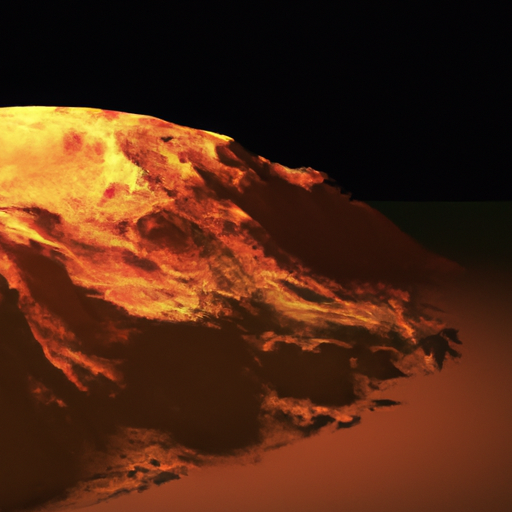You recently stumbled upon some fascinating scientific findings that suggest the potential for life on Venus. Although traditionally perceived as an inhospitable planet, researchers have discovered traces of phosphine gas in the planet’s atmosphere, a substance that could be produced by living organisms. In this article, we will take a closer look at these recent discoveries and explore the exciting implications they hold for our understanding of the universe. So, buckle up and get ready to embark on a journey through the cosmic possibilities of life beyond Earth.
Overview of Venus
Venus, often referred to as Earth’s sister planet due to their similar size, is a fascinating celestial body that has captivated the curiosity of scientists and space enthusiasts alike. With a diameter of about 12,104 kilometers (7,521 miles), Venus is only slightly smaller than Earth. However, its surface conditions differ greatly from our home planet, making it an extreme and inhospitable environment.
Physical characteristics
One of the prominent features of Venus is its thick atmosphere, which consists mainly of carbon dioxide (about 96.5%) and traces of nitrogen and other gases. This dense atmosphere creates a runaway greenhouse effect, resulting in scorching surface temperatures that can reach an astonishing 900 degrees Fahrenheit (475 degrees Celsius). Venus possesses a crushing surface pressure that is about 92 times greater than Earth’s atmospheric pressure. Despite these harsh conditions, Venus exhibits intriguing characteristics that have piqued scientists’ interest.
Atmosphere composition
The composition of Venus’ atmosphere not only contributes to its extreme heat and pressure but also gives rise to unique atmospheric phenomena. The thick layers of clouds in Venus’ atmosphere consist of sulfuric acid, creating a dense and acidic veil that obscures its surface from view. These clouds are believed to be responsible for Venus’ highly reflective atmosphere, making it shine brilliantly in the night sky. Understanding the composition of Venus’ atmosphere is crucial in unraveling the mysteries that lie beneath its inhospitable exterior.
Historical Perspective
Throughout history, humans have looked to the skies and wondered about the nature of Venus. Early beliefs about this enigmatic planet were often influenced by mythology and folklore.
Early beliefs about Venus
In various ancient cultures, Venus was associated with different deities and held symbolic meanings. For example, in Roman mythology, Venus was the goddess of love and beauty. The Babylonians, on the other hand, regarded Venus as both the morning and evening star, attributing it with religious significance. These early beliefs laid the groundwork for the curiosity and interest that would later drive scientific exploration of Venus.
Space exploration missions
The Age of Space Exploration brought unprecedented opportunities to study Venus up close. The first mission to provide a comprehensive examination of Venus was NASA’s Mariner 2 in 1962, which provided valuable data about the planet’s atmosphere and confirmed the extreme surface conditions. Subsequent missions, such as the Soviet Venera probes and NASA’s Pioneer Venus, expanded our knowledge further, revealing insights about Venus’ geology, atmosphere, and weather patterns. These missions paved the way for an in-depth exploration of the mysteries that lay hidden beneath Venus’ hostile environment.

Extreme Environment of Venus
Venus presents an array of extreme conditions that make it an inhospitable environment for life as we know it.
High temperatures
Venus boasts the hottest surface temperatures in our solar system, even exceeding the boiling point of lead. The thick atmosphere traps solar radiation, leading to a greenhouse effect that creates a scorching inferno on its surface. The intense heat poses numerous challenges for spacecraft, as it can melt or damage sensitive equipment. This extreme temperature range makes it unlikely for life as we know it to exist on Venus.
Pressure and acidic clouds
Alongside its searing heat, the atmospheric pressure on Venus is incredibly high. Comparable to being under more than 900 meters (3,000 feet) of water on Earth, the crushing pressure on Venus would be instantly fatal to humans. The dense atmosphere also harbors clouds composed of sulfuric acid, which shroud the planet and contribute to its reflectivity. The corrosive nature of these clouds further reinforces the hostile environment of Venus and hinders the chances of supporting life.
Volatile History of Venus
Despite its seemingly desolate appearance, Venus has a complex geological history that showcases evidence of past volcanic activity and impact cratering.
Geological activity
Venus displays signs of extensive geological activity, including vast volcanic plains, mountain ranges, and rift zones. These features suggest that volcanic processes have played a significant role in shaping the planet’s surface. The presence of tectonic activity, such as rift zones, indicates that Venus may still possess internal heat sources. Studying these geological formations sheds light on the planet’s unique history and helps scientists understand the processes that shape rocky planets.
Volcanism and impact cratering
Volcanism on Venus has left a lasting imprint on its surface. It is believed that the planet experienced a period of intense volcanic activity in the past, with lava flows and volcanic domes covering large portions of its landscape. The absence of large impact craters in some regions further indicates a relatively young surface, constantly renewed by volcanic processes. By studying the volcanic and impact features on Venus, scientists gain valuable insights into the geological evolution of rocky planets and the forces that drive their activity.

The Search for Life on Venus
While the inhospitable conditions make it unlikely for life as we know it to survive on Venus, the possibility of microbial life still captivates the imaginations of scientists.
Past assumptions and limitations
For many years, the extreme environment of Venus was considered inhospitable for any form of life. The focus of astrobiology and the search for extraterrestrial life shifted primarily towards Mars and moons of Jupiter and Saturn, where the conditions seemed more promising. However, recent discoveries and advances in technology have sparked a renewed interest in exploring the potential for life on Venus.
Recent scientific interest
Recent scientific findings have propelled Venus back into the spotlight as a potentially habitable world. The detection of phosphine gas in Venus’ atmosphere, a compound strongly associated with biological activity on Earth, has generated significant excitement among researchers. The potential existence of life in such an inhospitable environment challenges our assumptions and expands the possibilities for life beyond Earth.
Discovery of Phosphine Gas
The detection of phosphine gas in Venus’ atmosphere has served as a catalyst for further exploration and investigation into the possibility of life on the planet.
Understanding phosphine
Phosphine, a toxic gas composed of three hydrogen atoms bonded to a phosphorus atom, is highly reactive and has various industrial applications on Earth. It is primarily produced through biological processes, such as anaerobic bacteria and certain types of fungi. The presence of phosphine in Venus’ atmosphere is intriguing, as it hints at potential biological activity or unknown non-biological processes.
Methods of detection
The discovery of phosphine on Venus took place through advanced spectroscopic measurements made by ground-based telescopes and space observatories. These instruments analyze the chemical composition of a planet’s atmosphere by detecting specific wavelengths of light that are absorbed or emitted by different molecules. This groundbreaking detection of phosphine has raised numerous questions and has spurred the scientific community to delve deeper into the mysteries of Venus.

Significance of Phosphine
The presence of phosphine on Venus has significant implications for astrobiology and our understanding of the potential for life beyond Earth.
Potential biological origins
Given that phosphine is primarily associated with biological processes on Earth, the detection of this compound on Venus raises intriguing possibilities. It suggests the existence of microbial life that thrives in the planet’s acidic clouds, where the conditions are less extreme. Microorganisms adapted to Venus’ harsh environment could potentially produce phosphine as a metabolic byproduct, leading to the intriguing notion of a Venusian biosphere.
Controversies and skepticism
However, the presence of phosphine alone does not conclusively prove the existence of life on Venus. There is ongoing debate among scientists regarding the accuracy of the detection and the interpretation of the data. Skeptics argue that alternative non-biological sources or unknown chemical processes could be responsible for the observed phosphine levels. The scientific community continues to scrutinize the findings, highlighting the necessity for further investigations and explorations to ascertain the true nature of this intriguing gas.
Alternative Explanations
While the potential biological origins of phosphine gas on Venus are fascinating, alternative explanations must also be considered.
Non-biological sources of phosphine
While phosphine is typically associated with biological activity, there are known non-biological sources that could account for the observed levels on Venus. For instance, photochemical reactions involving sunlight and different compounds in the atmosphere could potentially produce phosphine. Additionally, volcanic activity and the presence of certain minerals could contribute to the production of phosphine through non-biological processes. Further research is necessary to evaluate these alternative sources of phosphine and their likelihood.
Other compounds of interest
In addition to phosphine, the search for potential signs of life on Venus extends beyond a single compound. Scientists are also investigating the presence of other chemical compounds that could potentially hint at biological activity. For example, the detection of certain organic molecules or isotopic imbalances could provide further evidence of life or its remnants. The ongoing analysis of Venus’ atmosphere seeks to identify these compounds and unravel the mysteries of this enigmatic planet.

Exploring Venus Further
To gain a comprehensive understanding of Venus and its potential for life, future robotic missions and advanced scientific instruments are essential.
Future robotic missions
Proposed missions, such as NASA’s VERITAS (Venus Emissivity, Radio Science, InSAR, Topography, and Spectroscopy) and ESA’s EnVision, aim to study Venus in greater detail. These missions will employ state-of-the-art instruments and advanced imaging techniques to map Venus’ surface, investigate its geological features, and analyze its atmosphere more thoroughly. Robotic landers and orbiters equipped with specialized tools will gather data and expand our knowledge of this captivating planet.
Investigating Venusian surface and atmosphere
In addition to further exploration of Venus’ surface, analyzing its atmosphere and collecting samples is crucial. Advanced spectroscopic instruments capable of detecting a wide range of chemical compounds will enable scientists to search for additional signs of life or chemical processes that could explain the presence of phosphine. By studying the climatic conditions and the geological makeup of Venus, we can gain valuable insights into the evolution of climates and rocky planets, aiding our understanding of habitability across the universe.
Implications and Importance
Understanding Venus and its extreme environment has broader implications beyond our neighboring planet.
Understanding climate evolution
By studying Venus’ runaway greenhouse effect, scientists can gain important insights into the long-term consequences of climate change on Earth. Venus serves as a cautionary tale for understanding how greenhouse gases can dramatically alter a planet’s climate and render it inhospitable for life as we know it. The knowledge gained from studying Venus can inform our efforts to combat and mitigate the effects of climate change on our own planet.
Comparison with other habitable worlds
Analyzing Venus and its unique characteristics allows us to compare and contrast it with other potentially habitable worlds, such as Mars, exoplanets, and moons within our own solar system. Understanding the extremes of Venus and the potential for life in its unforgiving environment helps us refine our methods for detecting signs of life in other celestial bodies. This knowledge widens our perspective on the possibilities for habitability and pushes the boundaries of our exploration into the vast cosmos.
In conclusion, Venus remains an enigmatic world with extreme conditions that challenge the existence of life as we know it. However, recent scientific findings, particularly the detection of phosphine gas, have unveiled the potential for microbial life in its seemingly inhospitable environment. The exploration of Venus has unveiled its volatile history, extreme environment, and the importance of understanding its climate evolution and habitability. As we continue to delve into the mysteries of Venus, future robotic missions and advanced scientific instruments will play a crucial role in unraveling the secrets of this captivating planet and expanding our understanding of life beyond Earth.
